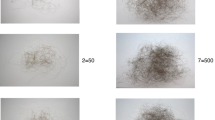Abstract
Eighteen inpatients affected by recurrent major depression were monitored in their clinical and biological features during the acute episode of illness. Diurnal mood variations rated with Visual Analogue Scale (VAS) and diurnal variations of skin body temperature were measured every 2 h consecutively for 2 days. Circadian rhythmicity of the two parameters was evaluated by cosinor analysis separately for each patient. The inspection of the individual cosine fitting shows that patients with a high circadian rhythmicity in perceived severity of symptomatology tend to show low circadian rhythmicity in skin body temperature, whereas patients with a low VAS oscillation tend to display a higher diurnal variation in skin body temperature. A chi-square test confirmed a statistical significance of the discordance between the two rhythms. We discuss our findings hypothesizing a different degree of entrainment of the disease process to the main circadian pacemaker.
Similar content being viewed by others
Author information
Authors and Affiliations
Additional information
Received: 13 May 1997 / Accepted: 4 March 1998
Rights and permissions
About this article
Cite this article
Barbini, B., Benedetti, F., Colombo, C. et al. Perceived mood and skin body temperature rhythm in depression. European Archives of Psychiatry and Clinical Neurosciences 248, 157–160 (1998). https://doi.org/10.1007/s004060050033
Issue Date:
DOI: https://doi.org/10.1007/s004060050033




